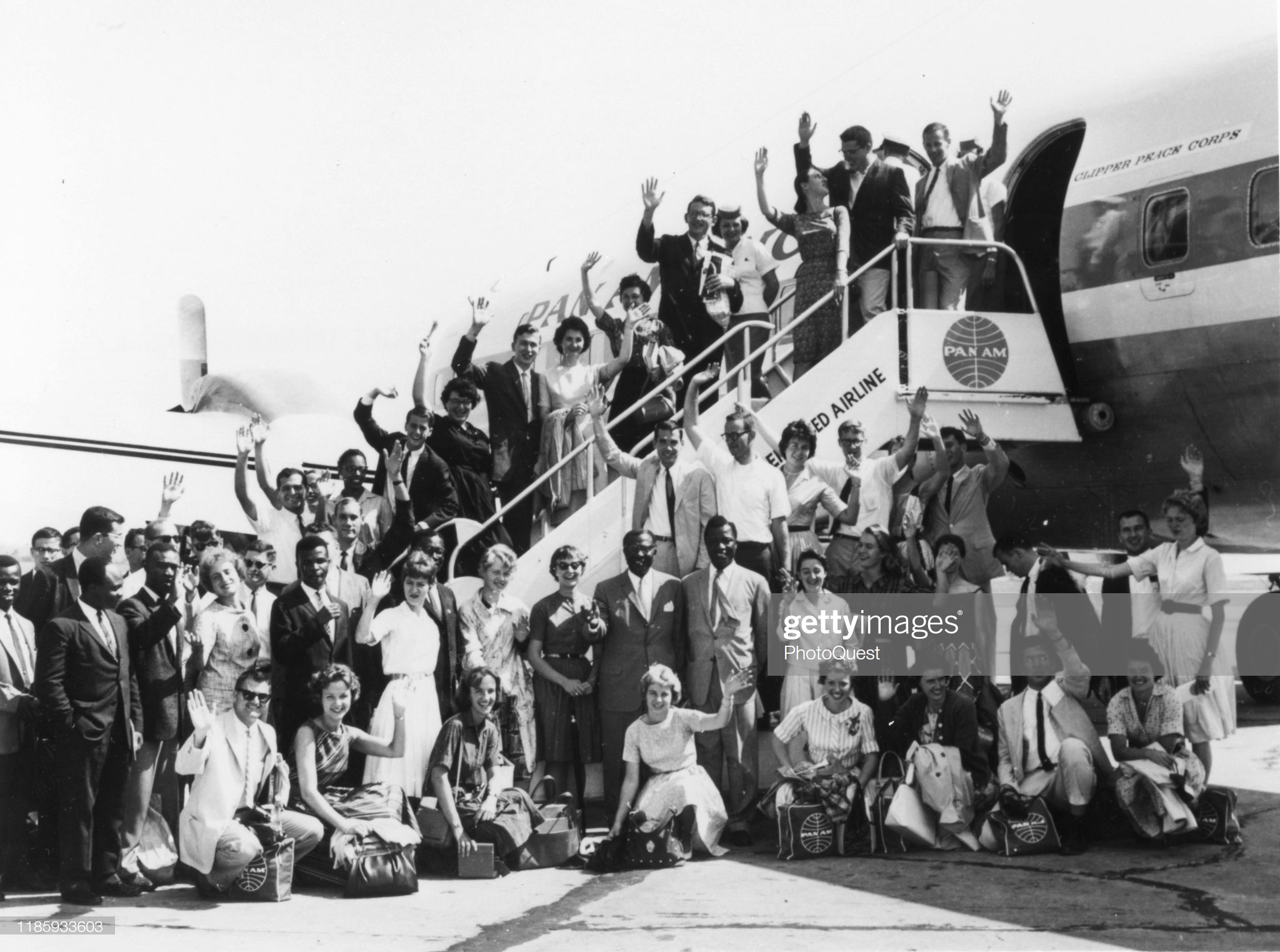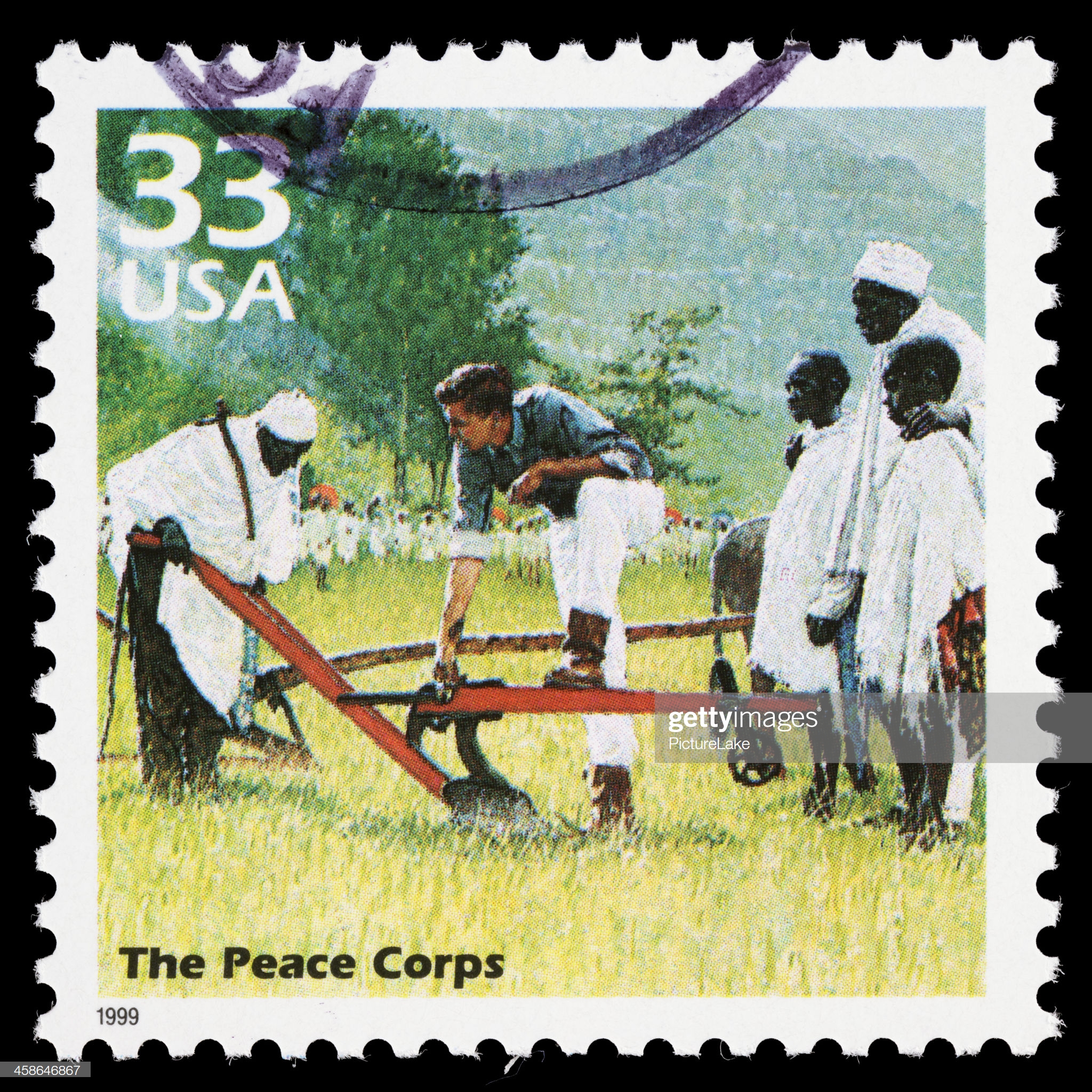Peace Corps Volunteers as Global Citizens
CELEBRATING THE THIRD GOAL
Peace Corps Volunteers as Global Citizens
“I therefore propose . . . a Peace Corps of talented young men and women willing
and able to serve their country . . . as ‘ambassadors of peace.’” — John F. Kennedy
in his campaign speech at the Cow Palace, November 2, 1960

The first groups of Peace Corps Volunteer as they wave from the tarmac before boarding a Pan Am plane to Ghana, August 28, 1961.(Getty Images)
A day after his inauguration, President Kennedy called Sargent Shriver and asked him to start figuring out if the Peace Corps idea really made sense. Shriver immediately called Harris Wofford, who had worked on the campaign, and the two of them reached out to others. Among those were Warren Wiggins and Bill Josephson, who had written a 30-page proposal, “The Towering Task,” which became the new agency’s blueprint.
This task force established three official goals for the Peace Corps, which Wofford later summarized in his book Of Kennedys & Kings:
First Goal: It can contribute to the development of critical countries and regions.
Second Goal: It can promote international cooperation and goodwill toward this
country.
Third Goal: It can also contribute to the education of America and to more intelligent
American participation in the world.
Most Americans are aware of the first two goals, although they might express them differently. But many of our fellow citizens are unaware of the third goal, which is ironic since “the education of America” is a goal that Returned Peace Corps Volunteers (RPCVs) have worked hard to achieve, in solid and exciting ways. It is time now — 2021, the Peace Corps’ 60th anniversary year, for us to recognize — and quantify — what RPCVs have accomplished since their days of service.
I propose that the Peace Corps Fund recruit and pay an RPCV graduate student or someone who has recently left grad school, to produce a statistical study documenting what RPCVs have accomplished not only in their former countries of service but here at home.
These statistics will become the springboards of articles and opinion pieces about the valuable “Third Goal” work done by Returned Peace Corps Volunteers in the last 60 years — stories that the Peace Corps Fund will seek to place in a variety of publications, print and digital, to inform and inspire the American public.
The research will coincide with the 2020 publication of Sargent Shriver’s manuscript The War on Poverty. In early 2021, the National Peace Corps Association (NPCA) will co-host with the JFK Library and Museum a special event to promote the book and what it means to be a global citizen. The event will be the first of dozens across the country in celebration of the 60th anniversary of the founding of the Peace Corps.
Here’s an overview of RPCV History
- RPCVs, who have served in 141 countries since 1961, now dominate the ranks of our Foreign Service, some as State Department diplomats, others as officers of USAID, USDA and MCC programs overseas.
- RPCVs work for dozens of non-government organizations (NGOs) throughout the developing world.
- Dozens of RPCVs have written award-winning novels and nonfiction focused on their overseas experiences and the countries they came to know as Volunteers. Paul Theroux(Malawi), and Peter Hessler (China) to name just two.
- Many RPCVs have sought, and won, elective office at the federal and state levels. Three former Volunteers currently serve in Congress: John Garamendi (Ethiopia), Joseph Kennedy (Dominican Republic), and Donna Shalala (Iran). The current governor of Pennsylvania, Tom Wolf, served in India.
- RPCVs include a number of important media figures who have brought their international experience to bear, such as Hardball host Chris Matthews (Swaziland), Vanity Fair reporter Maureen Orth (Colombia), former This Old House host Bob Vila (Panama), movie producer Gordon Radley (Malawi) and Netflix CEO and founder Reed Hastings (Swaziland).
- RPCVs are the quintessential entrepreneurs, with hundreds returning home to launch social enterprises and non-profits.
- Since the Peace Corps’ inception, thousands of “dual service” Volunteers have entered the armed forces after leaving the Peace Corps. Naval Intelligence Officer and Bronze Star recipient Ed Crawford (Dominican Republic), Air Force Brigadier General John Putnam (Thailand), and Korean and Vietnam War veteran Otis Montgomery (Malaysia) are all Returned Peace Corps Volunteers.
Those are better known, but there are thousands of more RPCVs who have demonstrated that, for them, the Peace Corps was not just two years of service. It was an experience that transformed them into Global Citizens, enacting the Third Goal of creating “intelligent American participation in the world.” These RPCVs have organized “Friends Of ” groups in the U.S. and returned again and again to their countries of service, where they provide financial help and other opportunities to the host country nationals who became their friends. It is their Peace Corps service that uniquely qualifies them to do this.
As Volunteers, they immersed themselves in the local language and culture; their hard work and commitment earned the trust of local decision-makers and institutions. As Volunteers, they came to truly understand another country’s culture and needs. Now, as Global Citizens, they are able to help meet some of those needs.
- For example: The RPCVs of Afghanistan, organizing together as Friends of Afghanistan, focus on women’s empowerment. Having served in-country from 1962 to 1979, they have concentrated on building schools, purchasing school supplies, and assisting a women’s leadership academy. Tens of thousands of Afghan girls and women have benefited from their efforts.
- Another example: RPCVs have encouraged their host country national students, to attend American colleges and universities, and helped them to do so. Kul Gautam of Nepal, the former Deputy Executive Director of UNICEF, has said, “My journey from Nepal to Dartmouth, then on to Princeton and the United Nations, would not have happened had it not been for the Peace Corps. And I know mine is not a unique case. There are thousands of boys and girls in developing countries whose lives have been transformed by the Peace Corps.”
Kennedy and Shriver believed that Volunteers would not only change other countries, but they would also change their own. RPCVs often do that as teachers; as many as one out of three recently returned Volunteers enters the field of education. Returning to the U.S. with skill sets developed overseas, they “contribute to the education of America” as teachers in classrooms across our country, sharing with the successive generations of adults their stories of living and learning at the edges of the world. In 2018, the National Teacher of the Year was Mandy Manning of Spokane, Washington, who served as a Peace Corps teacher in Armenia.
RPCVs also change America in the simplest of ways: by returning home and raising children who are endowed with their parents’ values and vision. Most children of RPCVs grow up believing that they are citizens not just of America, but of the world. Many children of the first and second generation of Peace Corps parents have themselves become PCVs.
My question to all RPCVs.
How are you fulfilling the Third Goal of the Peace Corps Act? What is your story of helping your host country and/or a host country national after you left your Peace Corps site?
Please send me your story so I might post it on our site and tell the true story of the agency, the work that RPCVs continue to do for the world. Thank you.
John Coyne:

JOHN, many of us early 1960s RPCVs almost immediately got involved in Shriver’s domestic OEO programs upon returning home. E.g., I headed up an NGO in the South Bronx and introduced Head Start there by opening five such centers in distinctly different Bronx communities, while also starting Neighborhood Youth Corps programs, Medicaid Alert projects, etc.
Once President Johnson launched the War on Poverty, I won funds to set up multi-service centers in seven of New York City’s 26 designated antipoverty areas, each time engaging community residents who chose minority architects to design the centers around local services those residents decided were most needed.
Today, almost 55 years after serving in Peru, I now advocate the rights of people with disabilities and seniors while chairing the Bus and Rail Subcommittee of the Washington Metropolitan Area Transit Authority. (I also started to help refugees to resettle here until Trump began his War Against Refugees and Asylum-seekers.)
Thus, beginning by working alongside Blacks and Puerto Ricans in New York City, I also began volunteering in Asian American organizations at the local and national levels. In short, trying to serve so-called “Third World” countries as a PCV, I came to recognize that there were, and still are, communities here in the U.S. that deserve the kind of people-to-people commitment that John Kennedy inspired in us PCVs who went abroad.
Surely there are tens of thousand of other RPCVs like me who have continued their lives of service upon coming home to America. –Tino